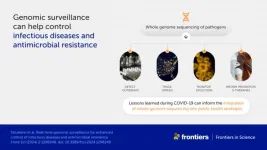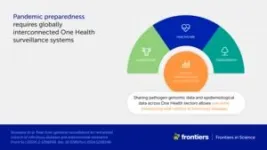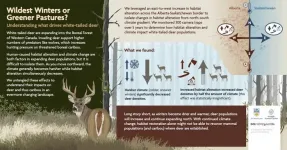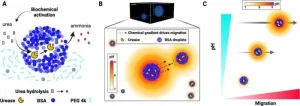(Press-News.org) The Covid-19 pandemic turned the world upside down. In fighting it, one of our most important weapons was genomic surveillance, based on whole genome sequencing, which collects all the genetic data of a given microorganism. This powerful technology tracked the spread and evolution of the virus, helping to guide public health responses and the development of vaccines and treatments.
But genomic surveillance could do much more to reduce the toll of disease and death worldwide than just protect us from Covid-19. Writing in Frontiers in Science, an international collective of clinical and public health microbiologists from the European Society for Clinical Microbiology and Infectious Diseases (ESCMID) calls for investment in technology, capacity, expertise, and collaboration to put genomic surveillance of pathogens at the forefront of future pandemic preparedness.
“Epidemic-prone infectious diseases cross borders as fast as people and trade goods travel around the world,” said lead author Prof Marc Struelens of the Université libre de Bruxelles, Belgium, and formerly Chief Microbiologist at the European Centre for Disease Prevention and Control (ECDC). “A local outbreak today may become the world’s next pandemic crisis tomorrow.”
A vital head start
Most illnesses not seen before in humans are zoonoses—diseases found in animals that infect humans. Many diseases in animals are also treated with antibiotics and other antimicrobials that are used for humans. However, the widespread use of antimicrobials in humans and animals has led to resistance, as microbes evolve to survive. So we face two major, overlapping public health threats: one from new infectious diseases that are zoonoses, and one from rising antimicrobial resistance. Tackling these threats requires a collaborative One Health approach—championed by the World Health Organization (WHO)—which recognizes that human health is dependent on the health of our ecosystem.
The answer, the scientists say, is to repurpose the increased genomic surveillance technology and capacity brought by Covid-19 to act as sentinels. Genomic surveillance that brings together public health agencies, veterinarians, and doctors need to be used to monitor human and animal diseases and antimicrobial resistance. By integrating epidemiological and clinical data from all these fields, we can get a comprehensive picture of pathogens and the risks they pose.
“Pathogen genomic surveillance is a tool that looks at the interplay between antimicrobial selective pressure on populations of microbes and the adaptive evolution of those microbes towards drug resistance,” said Struelens. “It lets us detect the emergence and disentangle the transmission dynamics of super-fit, multidrug-resistant epidemic clones—'superbugs’. Genomic surveillance can help track both zoonotic and inter-human transmission of viral variants, strains of bacteria, and signs of drug resistance.”
Rapid response
Real-time genomic surveillance of pathogens can allow us to quickly detect new strains of resistant bacteria and new diseases making the jump between humans and animals, and to monitor their spread and evolution.
This information can inform vaccination campaigns, help design targeted treatments, and guide public health responses—all of which could help prevent epidemics from flaring up.
Monitoring whole genomes would also allow us to study new diseases and the evolution of known diseases in more depth, to gauge how dangerous they are and identify countermeasures. In a globalized world, where pathogens travel quickly, genomic surveillance would make it possible to diagnose and treat infections equally quickly.
Struelens and his colleagues highlight how new sequencing technologies, including long-read genomic sequencing, ultra-rapid sequencing, and single-cell sequencing, and artificial intelligence are helping to drive progress in surveillance in some parts of the world.
“There are many places where genomic surveillance is already providing crucial protection against the spread of disease,” said Struelens. “This includes foodborne infections in Europe, North America, and Australia, and epidemic viral diseases like avian influenza across many countries worldwide.”
A connected world
To make genomic surveillance effective, the scientists say, we need worldwide, accessible, real-time data. To achieve this, we need massive investment in capacity and expertise that takes into account different levels of infrastructure and training available around the world. During the Covid-19 pandemic, countries that already had access to genomic surveillance expertise and equipment had a major advantage in monitoring the pandemic and tailoring their response. The authors provide a framework for the equitable implementation of globally interconnected surveillance systems that include lower- and middle-income countries.
“The article by Struelens et al. is a must-read for anyone interested in genomic surveillance as part of epidemic preparedness,” said Prof Marion Koopmans from the Erasmus Medical Center in Rotterdam, Netherlands, in an accompanying editorial. “The tools and ambition are there—the next step is to build equitable, collaborative surveillance infrastructures for future global health. The proposed WHO ‘Pandemic Treaty’ will be key, defining some of the rules of international engagement for better preparedness. Interesting times ahead!”
We also urgently need to invest in collaboration, to build bridges between disciplines in animal health, human, and public health, and to liaise between countries and health agencies. This will be critical to ensure not just that stakeholders can work together but that we reach agreements over data management and regulation, so that patients’ data is anonymized and safeguarded.
“To ensure universal participation in collaborative systems of genomic surveillance around the world, our critical challenges are sufficient laboratory and sequencing capacity, the training of an expert workforce, and access to validated genomic data analysis and sharing tools within a comprehensive, secure digital health information infrastructure,” said Struelens. “Integrating epidemic pathogen genomic information with epidemiological information must happen at scale, from the local to global level.”
END
Experts call for global genetic warning system to combat the next pandemic and antimicrobial resistance
Scientists champion global genomic surveillance using latest technologies and a ‘One Health’ approach to protect against novel pathogens like avian influenza and antimicrobial resistance, catching epidemics before they start
2024-04-25
ELSE PRESS RELEASES FROM THIS DATE:
Genetic variations may predispose people to Parkinson’s disease following long-term pesticide exposure, study finds
2024-04-25
A new UCLA Health study found certain genetic variants could help explain how long-term pesticide exposure could increase the risk of Parkinson’s disease.
While decades of research have linked pesticide exposure and Parkinson’s disease risk, researchers have sought to explain why some individuals with high exposure develop the disease while others do not.
One longstanding hypothesis has been that susceptibility to the disease is a combination of both environmental and genetic factors.
The new study, published in the journal NPJ Parkinson’s Disease, used genetic data from nearly 800 Central Valley (California) residents with Parkinson’s ...
Deer are expanding north, and that’s not good for caribou
2024-04-25
As the climate changes, animals are doing what they can to adapt.
Researchers from UBC Okanagan—which includes partners from Biodiversity Pathways’ Wildlife Science Centre, the Alberta Biodiversity Monitoring Institute, the University of Alberta, and Environment and Climate Change Canada—wanted to evaluate why deer densities in the boreal forest are rapidly increasing.
Over the past century, white-tailed deer have greatly expanded their range in North America, explains Melanie Dickie, a doctoral student with UBC Okanagan’s Wildlife Restoration Ecology Lab.
In the boreal forest of Western Canada, ...
Puzzling link between depression and cardiovascular disease explained at last: they partly develop from the same gene module
2024-04-25
Depression and cardiovascular disease (CVD) are serious concerns for public health. Approximately 280 million people worldwide have depression, while 620 million people have CVD. It has been known since the 1990s that the two diseases are somehow related. For example, people with depression run a greater risk of CVD, while effective early treatment for depression cuts the risk of subsequently developing CVD by half. Conversely, people with CVD tend to have depression as well. For these reasons, the American Heart Association (AHA) advises to monitor teenagers with depression ...
Synthetic droplets cause a stir in the primordial soup
2024-04-25
Our bodies are made up of trillions of different cells, each fulfilling their own unique function to keep us alive.
How do cells move around inside these extremely complicated systems? How do they know where to go? And how did they get so complicated to begin with? Simple yet profound questions like these are at the heart of curiosity-driven basic research, which focuses on the fundamental principles of natural phenomena. An important example is the process by which cells or organisms move in response to chemical signals in their environment, also known as chemotaxis.
A constellation of researchers from three different research units at the Okinawa Institute of Science ...
Future parents more likely to get RSV vaccine when pregnant if aware that RSV can be a serious illness in infants
2024-04-25
A nationwide survey of people who were pregnant or trying to become pregnant found that overall 54 percent expressed interest in the RSV vaccine during pregnancy. Perceiving RSV as a serious illness in infants was the strongest predictor of likely vaccination during pregnancy. Likelihood to receive the RSV vaccine during pregnancy was also higher among parents with a child at home already. Findings were published in the journal Pediatrics.
Respiratory syncytial virus (RSV) is a leading cause of infection among infants, frequently resulting in hospital or intensive care admission. RSV infection severe enough to require hospitalization has been associated with long-term wheezing ...
Microbiota enterotoxigenic Bacteroides fragilis-secreted BFT-1 promotes breast cancer cell stemness and chemoresistance through its functional receptor NOD1
2024-04-25
Tumor-resident microbiota in breast cancer promotes both the initiation and progression of cancer. However, the potential of targeting microbiota to enhance the efficacy of breast cancer treatment has not been comprehensively explored. In this study, researchers analyzed the microbial composition within breast tumors and identified a notable enrichment of ETBF in patients who exhibited resistance to taxane-based neoadjuvant chemotherapy.
Key findings from the study include:
Even at low biomass levels, ETBF ...
The Lundquist Institute receives $2.6 million grant from U.S. Army Medical Research Acquisition Activity to develop wearable biosensors
2024-04-25
The U.S. Army Medical Research Acquisition Activity (USAMRAA) has awarded The Lundquist Institute (TLI) a four-year grant totaling $2,623,234. The research project is led by Dr. Harry Rossiter, an investigator at TLI and Professor at the David Geffen School of Medicine at UCLA. The project aims to develop wearable multiplex biosensors to monitor exacerbation risk in chronic obstructive pulmonary disease (COPD).
COPD affects approximately 16 million Americans and is the third leading cause of death globally. Acute exacerbations of COPD (AECOPD), typically caused by a lung infection, are associated ...
Understanding the cellular mechanisms of obesity-induced inflammation and metabolic dysfunction
2024-04-25
A research team led by Professor Jong Kyoung Kim and Yujin Jeong (PhD candidate), from the Department of Life Sciences at Pohang University of Science and Technology (POSTECH) in collaboration with Professor Yun-Hee Lee and Cheoljun Choi (PhD candidate) from the College of Pharmacy at Seoul National University, Professor Young-Min Hyun and Koung-Min Park (PhD candidate) from Yonsei University College of Medicine, Professor James Granneman from Wayne State University (WSU), and Professor Young-Suk Jung from the College of Pharmacy at Pusan National University, ...
Study highlights increased risk of second cancers among breast cancer survivors
2024-04-25
Survivors of breast cancer are at significantly higher risk of developing second cancers, including endometrial and ovarian cancer for women and prostate cancer for men, according to new research studying data from almost 600,000 patients in England.
For the first time, the research has shown that this risk is higher in people living in areas of greater socioeconomic deprivation.
Breast cancer is the most commonly diagnosed cancer in the UK. Around 56,000 people in the UK are diagnosed each year, the vast majority (over 99%) of whom are women. Improvements in earlier diagnosis and in treatments mean that ...
International DNA Day launch for Hong Kong’s Moonshot for Biology
2024-04-25
International DNA Day Launch for Hong Kong’s Moonshot for Biology
The first emblematic species sequenced by the Hong Kong Biodiversity Genomics Consortium are published to coincide with International DNA Day. Joining a global “moonshot for biology” that aims to sequence, catalogue, and characterize the genomes of all of Earth's eukaryotic biodiversity.
A significant portion of modern knowledge in biology has emerged through sequencing the genetic code of the world’s biodiversity, which to date has been largely uncharacterized and increasingly ...
LAST 30 PRESS RELEASES:
Numbers in our sights affect how we perceive space
SIMJ announces global collaborative book project in commemoration of its 75th anniversary
Air pollution exposure and birth weight
Obstructive sleep apnea risk and mental health conditions among older adults
How talking slows eye movements behind the wheel
The Ceramic Society of Japan’s Oxoate Ceramics Research Association launches new international book project
Heart-brain connection: international study reveals the role of the vagus nerve in keeping the heart young
Researchers identify Rb1 as a predictive biomarker for a new therapeutic strategy in some breast cancers
Survey reveals ethical gaps slowing AI adoption in pediatric surgery
Stimulant ADHD medications work differently than thought
AI overestimates how smart people are, according to HSE economists
HSE researchers create genome-wide map of quadruplexes
Scientists boost cell "powerhouses" to burn more calories
Automatic label checking: The missing step in making reliable medical AI
Low daily alcohol intake linked to 50% heightened mouth cancer risk in India
American Meteorological Society announces Rick Spinrad as 2026 President-Elect
Biomass-based carbon capture spotlighted in newly released global climate webinar recording
Illuminating invisible nano pollutants: advanced bioimaging tracks the full journey of emerging nanoscale contaminants in living systems
How does age affect recovery from spinal cord injury?
Novel AI tool offers prognosis for patients with head and neck cancer
Fathers’ microplastic exposure tied to their children’s metabolic problems
Research validates laboratory model for studying high-grade serous ovarian cancer
SIR 2026 delivers transformative breakthroughs in minimally invasive medicine to improve patient care
Stem Cell Reports most downloaded papers of 2025 highlight the breadth and impact of stem cell research
Oxford-led study estimates NHS spends around 3% of its primary and secondary care budget on the health impacts of heat and cold in England
A researcher’s long quest leads to a smart composite breakthrough
Urban wild bees act as “microbial sensors” of city health.
New study finds where you live affects recovery after a hip fracture
Forecasting the impact of fully automated vehicle adoption on US road traffic injuries
Alcohol-related hospitalizations from 2016 to 2022
[Press-News.org] Experts call for global genetic warning system to combat the next pandemic and antimicrobial resistanceScientists champion global genomic surveillance using latest technologies and a ‘One Health’ approach to protect against novel pathogens like avian influenza and antimicrobial resistance, catching epidemics before they start







